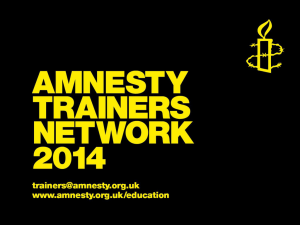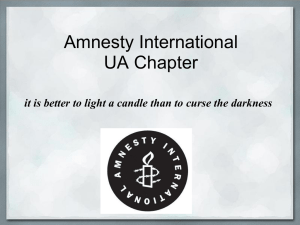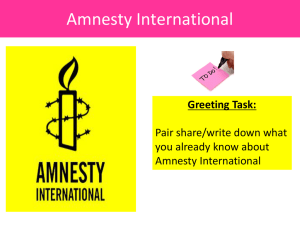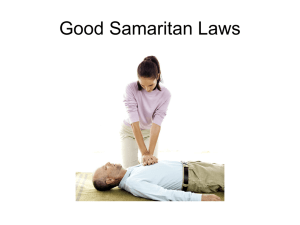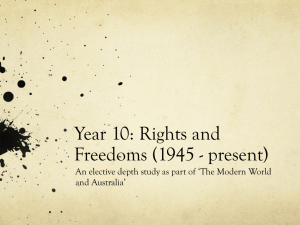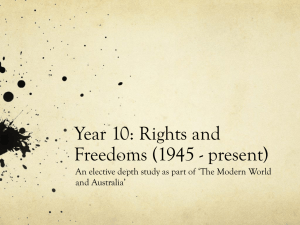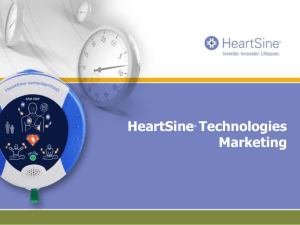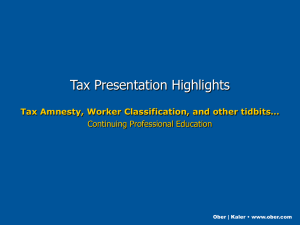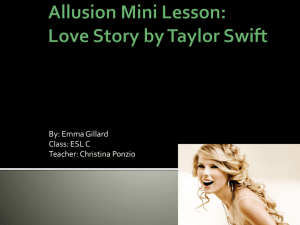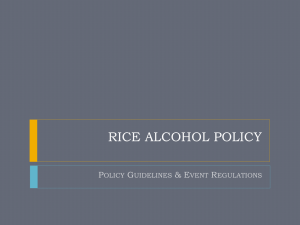911 Lifeline - Medical Amnesty
advertisement
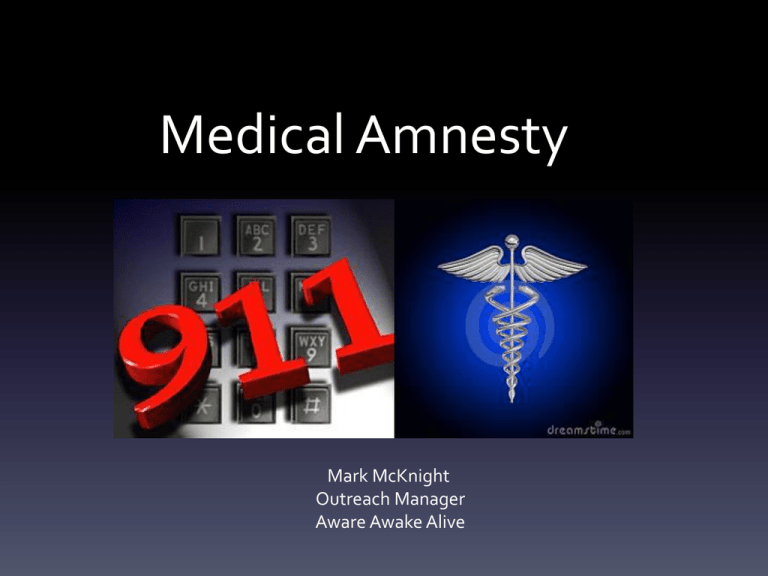
Medical Amnesty Mark McKnight Outreach Manager Aware Awake Alive What is a 911 Good Samaritan Policy? A Good Samaritan Policy (GSP, also known as a Medical Amnesty Policy) is a policy that saves lives by preventing the hesitation of students during medical emergencies involving alcohol or drugs. Many students are fearful and hesitant to alert authorities during medical emergencies because they fear harsh disciplinary responses to drug and alcohol violations. These hesitations during a life threatening emergency can be fatal yet prevented. The Good Samaritan Policy provides amnesty and protection from disciplinary consequences for the students involved in a medical emergency in an effort to promote fast action responses. Levels of Protection Individual amnesty • Individual amnesty is the most limited level of protection. This level protects individuals who are seeking medical attention for themselves as a result of an illegal action. Individual amnesty does not extend to organizations that person may be a part of or peers also present with the individual at that time. Caller amnesty • These policies, also known as Good Samaritan policies, protects individuals who call for another person seeking medical attention as a result of an illegal action. Liability protection in medical amnesty policies can often extend to those seeking help regardless if they are the one who is given medical assistance. This policy builds on individual amnesty but does not guarantee protection from legal prosecution for an organization the persons are a part of or attending. Levels of Protection Organizational amnesty • Protects an organization that is related to the event at which medical attention is sought as a result of an illegal action. Organizational amnesty would extend liability protection to fraternities, sororities, clubs and other social venues that may have people at their location who are under the influence of certain intoxicants. This level of amnesty allows for the largest level of protection and is subsequently the most controversial as well. Various institutions provide medical amnesty to individuals and callers but do not extend amnesty to organizations that may be involved. Example of Good Samaritan Policy: Amherst College “Because the safety and welfare of students is the college’s priority, the college has instituted a medical amnesty policy. This policy is applicable to the following parties: 1) student requesting medical assistance for oneself; 2) student requesting medical assistance for another person; 3) student for whom medical assistance was provided. When responding to such AOD (alcohol or drug) violations, the college will consider the student’s decision to request medical assistance, and in most cases, view the act of seeking medical assistance as good judgment, therefore not deserving of the typical range of AOD sanctions. Thus, if it is determined that the medical amnesty policy applies to a situation, the students involved will not be subject to a violation of the AOD Policy. Referral for AOD education still applies, and, in some instances, parental notification. This policy does not protect students who repeatedly violate college policies. Once a student receives Medical amnesty, future amnesty is at the discretion of the Dean of Students Office. The Dean of Students also have the discretion to determine that this policy does not apply in more serious situations, including criminal possession of drugs, property damage, violence, etc.” Quick Facts • Good Samaritan Policies have been proven to be effective at saving lives. A 2006 study in the International Journal of Drug Policy found that emergency calls increased after Cornell University’s Good Samaritan Policy was enacted in 2002, although alcohol abuse rates have remained relatively constant. • Good Samaritan Policies are not a violation of federal law. The Drug-Free Schools and Communities Act explicitly states that “a disciplinary sanction may include the completion of an appropriate rehabilitation program.” Follow-up evaluations and counseling are fundamental components of any Good Samaritan Policy. • Good Samaritan Policies shouldn’t be viewed as “get out of jail free cards” or rewards for binge drinking. Rather, they provide students with the clarity they need in order to make responsible, life-saving decisions during confusing and stressful party situations. Every minute spent worrying about judicial consequences is another minute it will take for help to arrive. That minute can very literally be the difference between life and death. • Campus administrators are correct in wanting to send the right message. And a Good Samaritan Policy would send the message that campus officials care more about keeping students alive than punishing them. • More than half of the schools with Good Samaritan Policies provide coverage for situations involving all drugs, not just alcohol. This is logical, since marijuana is often involved in party situations and can serve as a deterrent to calling for help, whether or not the drug was involved in the overdose. • The primary intention of a Good Samaritan Policy isn’t to reward those who make the decision to call for help when a friend is in trouble. Rather, the policy enables and empowers students to make that decision when they would otherwise hesitate. It is a preemptive policy that promotes responsible behavior rather than a reactive policy that rewards responsible behavior after the fact. • Good Samaritan Policies are only effective if they guarantee amnesty in writing (usually in the student code of conduct) and the policy is widely publicized. If a school has the unwritten practice of excusing students from punitive consequences during emergency situations, but students don’t know about it, then it is like having no such policy at all. Policy Brief A policy brief is a short document that outlines and promotes a policy change. Creating a Policy Brief will aid in convincing your institution’s administration to change their Good Samaritan alcohol or drug policy. Policy Brief Essentials ● Be sure to show urgency and course of action ● Be professional and not academic, write in a simplistic manner in which all readers can easily understand ● Be practical and use statistics for evidence ● LAYOUT (Brief should be one page.) ○ 1st section ■ Title of Brief ■ Executive Summary – aims to convince the reader that the brief is worth in depth investigation. ● A description of the problem addressed (often in the form of a key policy question the brief is designed to answer) ● A statement on why the current approach/policy needs to be changed ● Your recommendation for action ○ 2nd section ■ Provides a short overview of the root causes of the problem ■ How did this issue come to be an issue? ■ Provide images and trend data – graphs, charts etc ○ 3rd section ■ Discuss different policy options (Having a GSP vs. Zero Tolerance) ■ Evaluations (Outline strengths and weaknesses of GSP) Introducing a Good Samaritan Policy at your institution • 1. INTRODUCTION. The first step to introducing a Good Samaritan Policy is to arrange a meeting with your institution’s policy makers. • 2. CAMPAIGN. If the policy makers reject your initial request for a policy change then it is time to campaign. For a successful campaign, you will need others to help and support you. • 3.) STUDENT GOVERNMENT One easy and effective way to demonstrate the student body’s opposition to bad campus drug policies is to have your student government pass a resolution calling for reform. Resources • The Medical Amnesty Initiative (www.medical amnesty.org) • Students for Sensible Drug Policy(www.ssdp.org)

